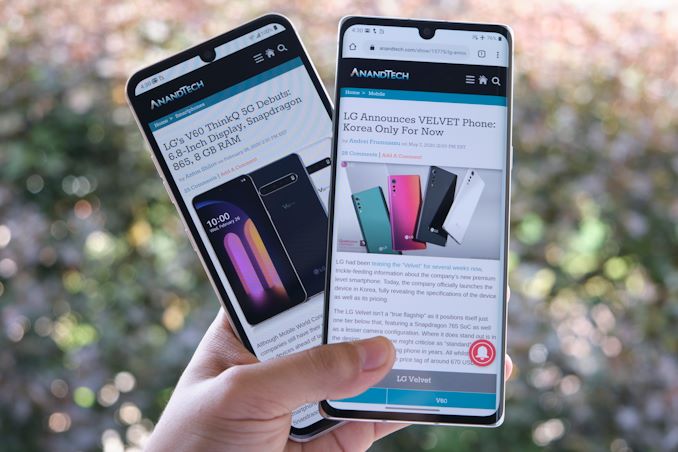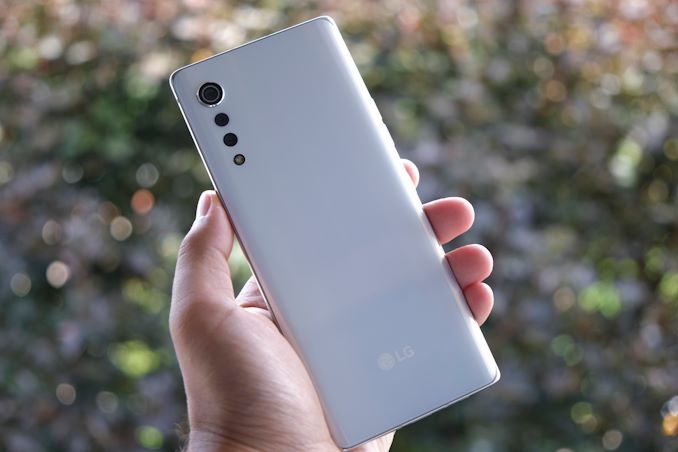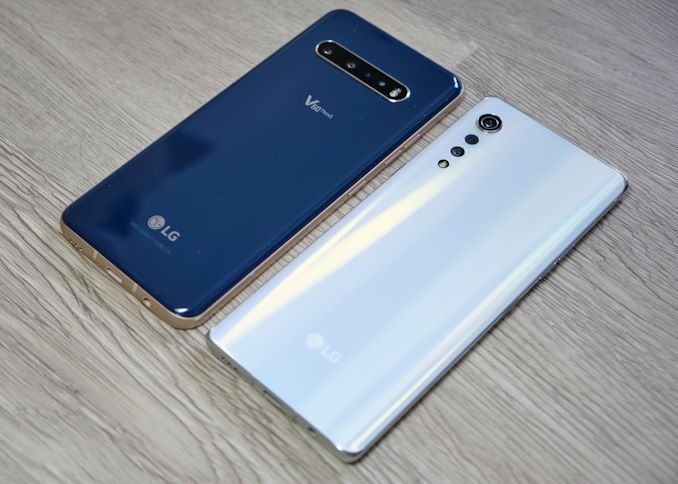The LG V60 and VELVET Review: A Classic & A Design Restart
by Andrei Frumusanu on July 15, 2020 9:00 AM EST
It’s been a few months since LG has released the LG V60, and since then the company has also finally managed to launch the new Velvet phone to western markets outside of Korea, such as Germany. The two new 2020 phones are quite contrasting devices for LG – representing what one could say the company’s classic design philosophy versus a newer, more refreshing design language. They’re also contrasting devices in terms of their specifications and positioning, with the V60 being a successor flagship devices with a high-end SoC, whilst the new Velvet is a “premium” design with the new Snapdragon 765, coming at a lower price point and some compromises in terms of specification – but not too many as to call it a mid-range phone.
Both phones are overdue a closer look, and that’s precisely what we’ll be doing today.
| LG 2020 Flagships | |||
| V60 | Velvet | ||
| SoC | Qualcomm Snapdragon 865 1x Cortex-A77 @ 2.84GHz 3x Cortex-A77 @ 2.42GHz 4x Cortex-A55 @ 1.80GHz |
Qualcomm Snapdragon 765 1x Kryo 475 (CA76) @ 2.3GHz 1x Kryo 475 (CA76) @ 2.2GHz 6x Kryo 475 (CA55) @ 1.8GHz |
|
| GPU | Adreno 650 @ 587MHz | Adreno 620 | |
| DRAM | 8 GB | 8 GB | |
| Storage | 128 GB UFS 2.1 +microSD |
128 GB UFS 2.1 +microSD |
|
| Display | 6.8" FullVision OLED 2460 x 1080 (20.5:9) |
6.8" FullVision OLED 2460 x 1080 (20.5:9) |
|
| Size | Height | 169.3 mm | 167.2 mm |
| Width | 77.6 mm | 74.1 mm | |
| Depth | 8.9 mm | 7.9 mm | |
| Weight | 218 grams | 180 grams | |
| Battery Capacity | 5000 mAh (Typical) | 4300 mAh (Typical) | |
| Wireless Charging | Qi | Qi | |
| Rear Cameras | |||
| Main | 64 MP 1/1.7" 0.8µm f/1.8 w/OIS |
48MP f/1.8 w/OIS |
|
| Wide | 13 MP 1/3.4" 1µm f/1.9 117° super-wide angle |
8MP Super-wide angle |
|
| Extra | ToF 1/4" 14µm f/1.9 117° super-wide angle |
5MP Depth |
|
| Front Camera | 10 MP 1/3.1" 1.22μm f/1.9 |
16MP | |
| I/O | USB 2.0 Type-C 3.5mm headphone jack Under-screen Fingerprint reader |
USB 2.0 Type-C 3.5mm headphone jack Under-screen Fingerprint reader |
|
| Wireless (local) | Wi-Fi 6 Bluetooth 5.1 |
Wi-Fi 6 Bluetooth 5.1 |
|
| Cellular | GSM, CDMA, HSPA, 4G/LTE, 5G | ||
| Splash, Water, Dust Resistance | IP68 | IP68 | |
| Dual-SIM | nano-SIM | nano-SIM | |
| Launch OS | Android 10 | Android 10 | |
| Launch Price | $899 | 599€ | |
In terms of specifications and the brains of the devices, as mentioned, the LG V60 is a familiar phone as it’s simply sporting the best of the best. The Snapdragon 865 features four Cortex-A77 cores, one of which clocks in at up to 2.84GHz and three others at up to 2.42GHz, paired with four low-power Cortex-A55 cores at 1.8GHz. We’ve seen excellent performance and power efficiency out of Qualcomm’s latest chipset in other 2020 flagship devices, and the LG V60 is pretty much in line with the pack in terms of performance and efficiency.
The LG Velvet on the other hand is amongst a smaller number of devices which make due with Qualcomm’s new Snapdragon 765 SoC. This “premium” model functionally has the same level of features as the flagship Snapdragon 865 SoC, but just comes at lower performance levels. In terms of IP, we find two Cortex A76 cores, one up to 2.3GHz and another up to 2.2GHz, paired with six low-power Cortex-A55 cores at 1.8GHz. The GPU in the form of the Adreno 620 is also smaller than the bigger brother’s Adreno 650 configuration.
What’s special about both these SoCs is that they’re 5G enabled. The LG V60 makes use of an external X55 modem for connectivity, while the Velvet integrates its modem capabilities inside of the Snapdragon 765.
Both phones feature 8GB of RAM (LPDDR5 for the V60 and LPDDR4X for the Velvet), and feature 128GB of storage, expandable via microSD slots.
In terms of designs, both phones are very different to each other. The one thing they share in common is the display specifications; both phones feature 6.8” 2460 x 1080 OLED displays. The resolution doesn’t surprise too much for the Velvet as it’s a lower priced phone, but it is quite weird to see LG go backwards on the V60, offering a downgrade from the 1440p resolutions of previous, smaller, V-series phones. There are battery life considerations here which we’ll discuss in more detail later, but it does stretch out quite a bit for displays of these sizes.
Both displays still make use of “dewdrop” notch designs and the cut-outs here are virtually identical between the two phones. The Velvet tries to smooth out the bezel corner near the cut-out via blacked out pixels, but other than that I wouldn’t be surprised if these were actually the same display panels.
Of course, the immediately visible difference between the two phones is their bezel designs. The V60 has a very classic look to it; a flat screen with some quite sizeable side bezels and a chamfered metal frame. The Velvet on the other hand is a lot more contemporary, employing a curved front screen design on its sides, with only a thin glossy metal frame.
You could argue that the V60 looks a lot more industrial, but for me the ergonomics of the Velvet are immeasurably better – it’s not only a physically narrower phone, but it just feels much better in hands thanks to its curvatures as well as thinner form-factor.
Despite the fact that the screen diagonals on both phones are identical, and maybe even have the same panels, the Velvet is a much handier phone. There’s also a big weight difference between the two units, as the V60 comes in at a hefty 218grams versus the Velvet’s 180g. Admittedly, the V60 uses a bigger 5000mAh battery whilst the Velvet is 14% smaller at 4300mAh (which is still respectable).
On the camera side of things, besides the SoC, it’s also where we see bigger differences between the two phones capabilities. The LG V60 has a new generation and larger 1/1.7” main camera sensor coming in with 64MP resolution, with a quad-Bayer colour filter layout binning down to 16MP in regular photos. LG uses this module’s high native resolution to achieve lossless 2x zooming – a necessity as the phone lacks a dedicated telephoto module.
The Velvet uses a similar method, albeit with a 48MP primary camera sensor that’s physically smaller in size than that of the V60’s.
In terms of ultra-wide-angle modules, the V60 features a 13MP sensor while the Velvet makes due with a mere 8MP unit. Besides price considerations, I think the Velvet might be limited by the thickness of the phone here and the deployable sensor sizes, as the phone lacks any protrusions with the UWA module sitting flush with the back glass panel (The main camera does have a small bump).
There’s also an extra ToF sensor on the V60, and unspecified 5MP depth sensor on the Velvet – both don’t actually serve as capturing modules but augment the capture abilities of the phones in modes such as portrait mode.
At the bottom of the phones, we see a similar setup of 3.5mm headphone jack, USB-C port and a three-holed bottom speaker setup (The top earpieces also serve as stereo speakers for playback). The fact that these phones still include the 3.5mm headphone jacks in 2020 makes them actually stand out to the rest of the competition who had opted to drop the useful connector in favour of profit making selling wireless audio accessories. Good on LG for sticking with their ethos.
Overall, the phones in terms of design are quite contrasting, and if you wouldn’t be familiar with them nor see their brandings, it would be hard to believe that they’re actually from the same company, released only a few months apart from each other. LG has had considerable trouble with the industrial design over the last few generations and the V60 is pretty much a continuation of that “outdated” look. The new Velvet is a fresh breath of air and I feel it actually belongs in 2020, its ergonomics are substantially better and the build quality is I feel higher than that of the V60, a bit ironic given that the two devices are positioned the other way around in terms of pricing and product categories.
















81 Comments
View All Comments
s.yu - Wednesday, July 15, 2020 - link
It's supposed to work, out of the box. Are standard so low these days that people expect phones to automatically break once their software is no longer supported? I just pray that updates don't break my phone.Also flagships should generally be expected to be supported for longer, my backup S6E still got a security update this year(not that I asked for it, but as updates go it kept nagging me to accept), and that was a 2015 device.
TheinsanegamerN - Thursday, July 16, 2020 - link
My moto z play hasnt recieved any updates in 2 years, still works perfectly. Hell my note 4 still technically works (without carrier support) and that thing is ancient.eastcoast_pete - Wednesday, July 15, 2020 - link
I am probably not representative of many here, but I find the "non-contemporary" design of the V60 a big plus. Just having a 3.5 mm connector has become rare amongst the so-called flagship phones. The main issue that make me hesitate to buy another LG is the lack of commitment by the company to keep the OS up-to-date until at least 2023. I've been burned by LG before on that. So, LG, put that commitment in writing, and we might have a deal.TheinsanegamerN - Thursday, July 16, 2020 - link
Android phones dont just stop working when OS updates stop, and even Google wouldnt supply updates that long.My note 4 still loads any modern android app, and its running android 5.0. The apps are still updated and get security updates, the underlying framework doesnt relly matter anymore, anything that does has been tied into the play store by now.
Quantumz0d - Thursday, July 16, 2020 - link
Exactly. The OS app support compat is light years ahead of iOS instead of bending over for the new OS update you can control the phone. And the OS itself is downgrading, people should read on Scoped Storage - It removes your access to your own files, apps need to hit share to make it visible to other apps just like iOS, and folders access doesn't exist, File Management is also hit with this, Developers are hit with this by making POSIX I/O libs optimized for generations are thrown out of window for that SAF abomination with performance hit and a total shitshow on copying Apple. The sad part is no Security updates, that could have been done at CTS level or even Playstore modules but no one cares about that which is what many people would be happier to see.The HW is excellent man for this device but no battery replacement unfortunately, Note 4 is the last of that tech, Uv sensor, removable battery, solid performance, it's a great device. I still have my SGS with aftermarket battery for it's DAC chip of Wolfson Audio.
As for the OP's design I agree about how the V60 maintains the old fantastic unique look than the iPhone / Chinese bump riddled ugly tile.
bhupatib - Wednesday, July 15, 2020 - link
1. ToF camera is not 14um it's 1.42. It's not USB 2.0 but USB 3.1 since they are both capable of Desktop Mode which requires 3.1 with displayport spec.
lmcd - Thursday, July 16, 2020 - link
It's 100% possible to max out at USB 2.0 bandwidth, support PD, and support DisplayPort Alt Mode.mrvco - Wednesday, July 15, 2020 - link
My LG V40 is still going strong and it has grown on me quite a bit since I got it shortly after launch at the end of 2018. I received the update to Android 10 and one security update since. I still use it as my day-to-day phone instead of an XS Max. The good news with LG phones is that as long as you are even a little bit patient there is no need to pay list price. I paid $550 for a NIB V40 a month after launch and full price at T-Mobile for the V60 (single screen) is $699.99 now. Without seeing or holding one, at 599€ (and whatever that ends up being in the US), the Velvet is a tough sell though.s.yu - Wednesday, July 15, 2020 - link
>The good news with LG phones is that as long as you are even a little bit patient there is no need to pay list price.Also true for Samsung phones. More people need to see that :)
Actually the only exceptions may be Apple and the Chinese phones, everybody else you can expect discounts through certain channels shortly after shipping.
patel21 - Wednesday, July 15, 2020 - link
Andrei, please post a similar review for A71 if possible.